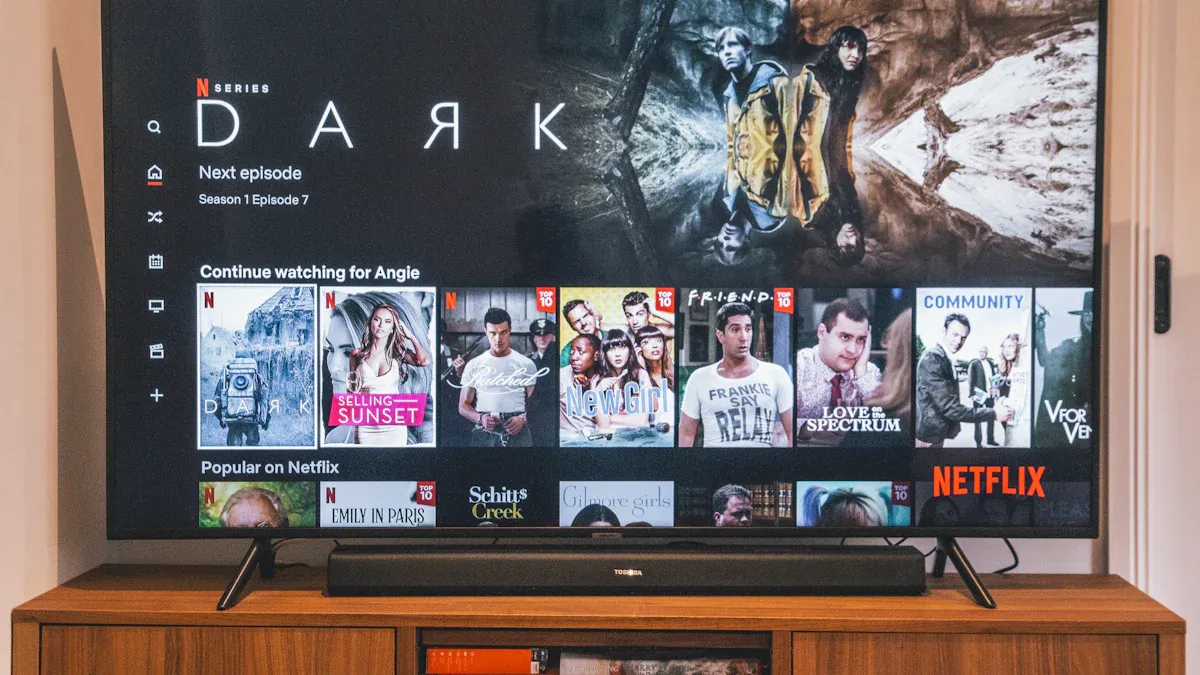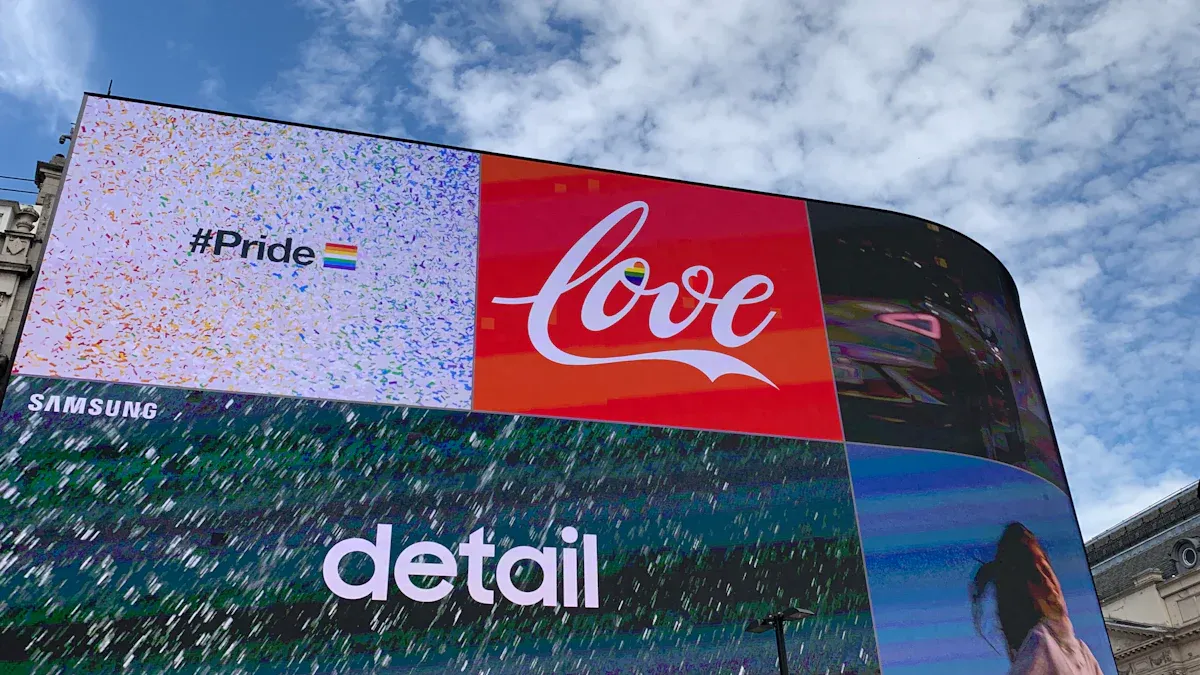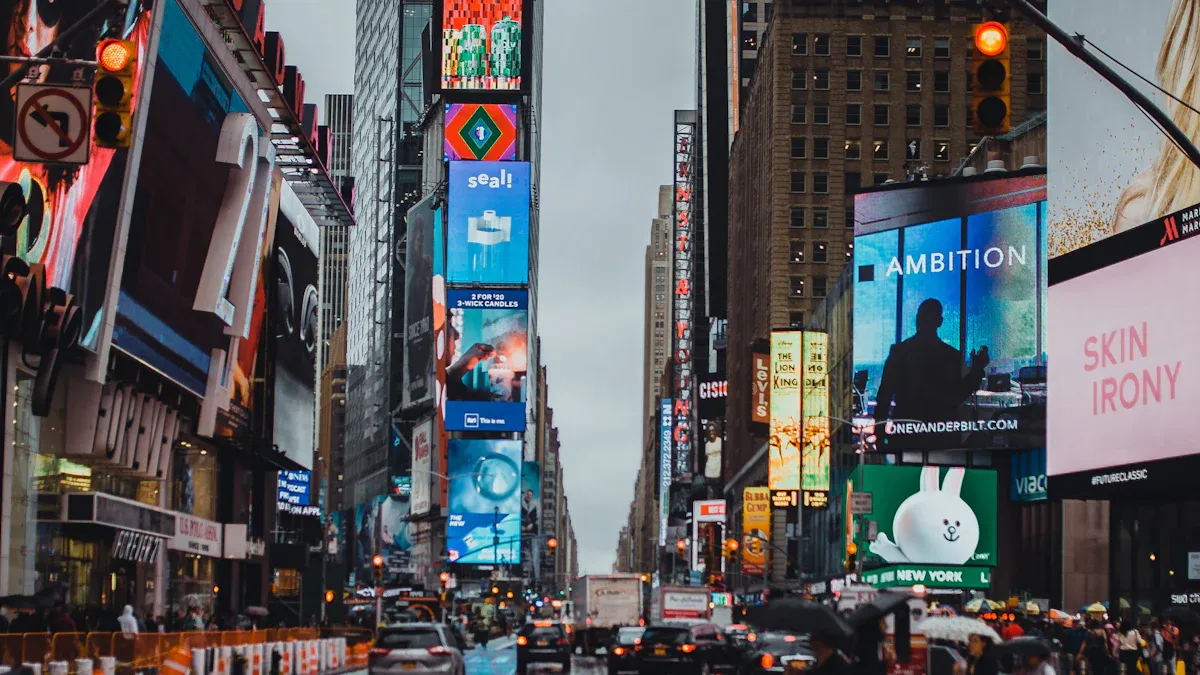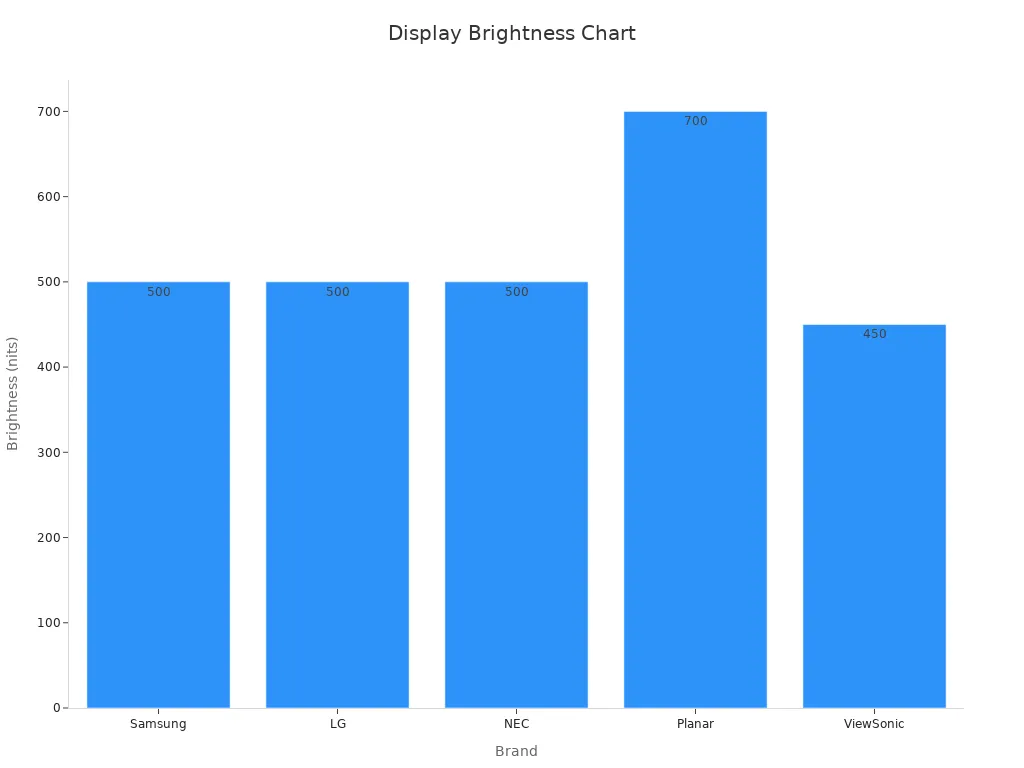Samsung vs. NEC Digital Signage Displays for Business Applications

In the samsung vs. nec debate, Samsung is known for smart features and bright display quality. NEC is praised for being very reliable and easy to use in many places. Picking the right commercial display helps business communication and brand image. People who decide should compare samsung vs. nec for how long displays last, how they fit in, their value, and digital signage needs. Each business has its own needs.
Key Takeaways
Samsung displays have bright screens and smart tools. They work well in busy places like stores and meeting rooms.
NEC displays are strong and last a long time. They are good for tough places like airports and outside areas where strength is important.
Both brands can run all day and night. They have good warranties. This helps businesses spend less on fixing and waiting for repairs.
Picking the best display depends on what your business needs. Think about where you will use it, how many screens you want, and which smart tools you need.
Planning ahead and choosing the right digital signage helps you talk to people better. It can help you sell more and make your business special.
Samsung vs. NEC: Quick Comparison

Key Differences
The samsung vs. nec comparison shows some big differences for businesses. Samsung digital signage displays are very bright and have smart features. They use AI to help manage content and let people interact with the screen. You often see Samsung displays in stores and hotels. These places need bright screens and smart tools. Samsung uses special cooling fans and coatings to make their displays last longer in busy places.
NEC digital signage displays are known for being reliable and saving energy. NEC makes their products for places like airports and hospitals. Their displays have strong cases and can handle bad weather. This makes them good for tough places. NEC is also good at connecting with other software. They offer cloud management that works with many programs.
Tip: Think about where you will use your display. Choose Samsung if you want smart features. Pick NEC if you need something tough and reliable.
Summary Table
Metric | Samsung Digital Signage Displays | NEC Digital Signage Displays |
|---|---|---|
Brightness (Indoor) | QMR Series: ~500 nits brightness | Focus on commercial grade |
Brightness (Outdoor) | OMN-D Series: 3,000 nits, dual-sided fan cooling | Emphasis on durability, energy efficiency |
Touch Technology | QB13R-T: Capacitive touch, 13" size | V654Q-T: Infrared touch, 65" size |
Typical Use Cases | Retail, offices, interactive compact displays | Directories, events, high-traffic environments |
Durability Features | Active cooling, anti-reflective coating, rugged chassis | Vandal-proof enclosures, IP56+ weather protection |
Integration & Connectivity | Multiple inputs, AI-powered content management | Cloud integration, interoperability with software |
Smart Features | AI, Transparent MICRO LED, real-time content adaptation | Energy efficiency, cloud-based platforms |
Warranty & Support | Commercial warranties, onsite repair options | Commercial warranties, professional support |
The samsung vs. nec debate is about what each brand does best. Samsung is great for new technology and interactive screens. NEC is strong and saves energy in hard places. Both brands give good support and warranties. But they focus on different things. Pick the one that fits your business needs for the best results.
Commercial Display Basics
What Are Commercial Displays?
Commercial displays are special screens made for businesses. They are not like regular TVs at home. These displays can stay on for many hours. They work well in busy places like stores, airports, and meeting rooms. Commercial displays are brighter and built to last longer. They also connect to many devices. People use them for digital signage and sharing information fast. You can also use them for interactive presentations.
Key features of commercial displays include:
They can run for 16 or 24 hours a day.
They are tough for use in public places.
They have many ways to connect to other devices.
They work with conference systems.
Note: Commercial displays help businesses show messages that are easy to see. They make people pay attention and understand the message.
Why Businesses Need Them
Businesses use commercial displays to talk to people better. These displays make meetings more fun and help people join in. Stores use them to show sales and help shoppers. Airports and hospitals use them to give updates and directions.
More businesses want commercial displays every year. The table below shows where they are used and what is popular:
Market Segment / Vertical | Demand Drivers and Trends |
|---|---|
Automotive | More OLED displays are being used |
Retail, Hospitality & BFSI | Digital signage is used more often |
Transportation | Big displays are needed |
Industrial & Enterprise | AR and VR are becoming common |
Healthcare | Displays help doctors see medical images |
Aerospace & Defense | HUDs and special displays are used |
Education | Online learning makes the market grow |
Meeting rooms use commercial displays for easy video calls and sharing. In North America, new technology helps more people use them. Asia Pacific is growing fast because of new factories. Europe likes gaming and virtual reality. Other places use more outdoor ads.
Tip: Pick a commercial display that fits your business. Think about if you need it for meetings, stores, or sharing public information.
Display Quality

Samsung Picture Performance
Samsung gives great picture quality with its advanced screens. The Samsung QM Series has 4k uhd resolution. This means images look sharp and colors are bright. Many businesses pick Samsung for places that need bright screens. These screens are easy to see, even in sunlight. The display can reach 4000 NIT brightness. This makes it good for both indoor and outdoor use.
Samsung’s 4k uhd screens have a 1200:1 contrast ratio. This helps pictures look clear and detailed. You can read the screen with polarized sunglasses. This is helpful outside. Samsung adds an ambient light sensor. It changes the brightness by itself. This saves energy and helps the screen work better. The MagicINFO Player is built in. It lets you manage and play content easily.
The table below shows important features of Samsung’s display quality:
Feature | Specification/Description |
|---|---|
Brightness | 4000 NIT, high brightness for sunlight readability |
Resolution | 4k uhd |
Contrast Ratio | 1200:1 |
Operation | 24/7 reliable performance |
Ambient Light Sensor | Yes, for optimized brightness |
Embedded Software | MagicINFO Player |
Durability | Overheat mitigation, IP5X dust resistance |
Orientation | Portrait or landscape |
Note: Samsung’s bright screens and 4k uhd resolution make them a good pick for businesses that want strong performance and dependability.
NEC Visual Performance
NEC digital signage displays, like the NEC ME Series, focus on steady performance and saving energy. The 4k uhd panels show clear pictures for presentations and public info. NEC makes its displays to last a long time in tough places. The high brightness keeps content easy to see in bright rooms.
NEC’s displays use special color calibration for true colors. The ME Series is easy to install in different ways. It works well for business needs. NEC’s visual performance is great for places that need reliable screens with little upkeep.
NEC ME Series features:
4k uhd resolution for sharp images
High brightness for visibility in bright areas
Energy-saving technology for lower operating costs
Tip: NEC displays are strong and last long, so they are a smart choice for businesses that want reliability and to save energy.
Smart Features
Samsung Smart Capabilities
Samsung digital signage displays have smart features for businesses. These displays use sensors and POS systems to show special content. This helps get customers interested and can help sales go up. Samsung’s cloud system lets you update screens from anywhere. You can change ads or schedules right away. This saves time and money.
Samsung’s displays use AI to watch how people use them. They also check how well the content works. This information helps companies make better choices. It also helps them improve their ads. The displays show moving content, so messages look new and fun. Samsung’s 4k uhd screens show clear and bright pictures. This makes it easy for people to read and enjoy.
Key features include:
Cloud management for updates from far away
AI tools to help make content better
Works with business tools and POS systems
Changes content fast when people interact
Shows sharp images with 4k uhd resolution
Samsung’s smart digital signage is like a message center. It takes the place of old bulletin boards and emails. It gives quick updates and special messages to workers and customers.
NEC Software Innovation
NEC is known for its smart software and strong features. The company uses a big AI supercomputer in Japan. This helps with research in language, pictures, and speech AI. NEC’s displays, like the nec me series, use this smart technology. They have cloud platforms and fast data tools. This means content shows up quickly and works well.
NEC uses Kubernetes and containers for flexible AI tools. This lets businesses get new features without hard setups. Their system checks if everything is working right. It watches the network and GPU health. Tools like Prometheus and Grafana help keep things running smoothly.
Notable features:
Cloud management that grows with your needs
Real-time checks and reports
Works with other software easily
Smart AI for special content
Fast data for big projects
Stays strong in busy places
NEC’s smart features help share messages in places like hospitals, airports, and schools. The displays give updates right away and help people work together. They also help use less paper. With 4k uhd resolution, NEC makes sure pictures are clear and easy to see.
Durability and Reliability
Samsung Build Quality
Samsung makes its commercial displays strong for busy places. The QLED series can run all day and still work well. Many malls and offices pick Samsung because the screens last a long time. These displays do not break easily from dust or heat. This helps them stay good in crowded spots.
Samsung QLED displays are great for malls and lobbies.
A big coffee shop chain put Samsung QLED menu boards in 200 stores. The screens worked well and got 15% more customer interest.
Workers at these stores liked how the screens worked every day.
Samsung uses tough parts and smart cooling to stop overheating. These things keep the screens safe from damage. The displays have special coatings to stop glare from lights. This keeps pictures clear and easy to see. Businesses trust Samsung because the screens work every day. Real use shows Samsung screens are good for busy business places.
Note: Samsung’s strong build means less fixing and less time when screens are broken.
NEC Mechanical Strength
NEC makes its digital signage displays to last in hard places. The company uses metal cases and strong frames. These things keep the screens safe from hits and people trying to break them. NEC screens are often in airports, hospitals, and outside where they must work well.
NEC has models with cases that keep out water and dust. These displays can handle rain, dirt, and hot or cold weather. Many NEC screens meet IP56 or better for water and dust safety. This makes them a good pick for outdoor signs.
NEC displays use hard glass and strong frames.
The screens do not scratch or break from lots of use.
NEC makes its products to work for years with little fixing.
Businesses that need screens in tough places often choose NEC. The company’s strong build helps stop problems. NEC is known for being reliable in important places.
Tip: If your business needs screens outside or in hard spots, NEC gives you strong displays you can trust.
Integration and Compatibility
Samsung System Integration
Samsung makes it easy to connect their displays with other systems. They use special technology like 3D IC X-Cube and 2.5D H-Cube. These help different parts work together in busy places. The connections are strong and do not take up much space. They also use less power, which saves energy. This helps businesses move lots of data and keep screens working well.
Samsung works with many business tools. For example, the SAP Integration Suite links about 30 systems. It can handle 100,000 transactions every day. This helps people make quick choices and manage projects better. Samsung’s ERP system is simple and easy to upgrade. It does not need many changes. Security is strong because it follows company rules and keeps data safe.
Key features include:
Fast data transfer with strong connections.
Works with ERP and cloud systems.
Watches for problems and sends alerts.
Easy updates and lower IT costs with one main system.
Tip: Samsung’s system helps businesses control many screens, protect data, and work together better.
NEC Integration Options
NEC gives many ways to connect digital signage. Their Digital Platform uses Kubernetes containers. This lets businesses start and grow projects fast. It works with AWS and helps collect and store data. NEC’s tools help save money on repairs and link with many cloud services.
NEC makes its tools fit with normal business systems. They use common data and tools, so everything works well together. In one example, NEC helped a business build a new user screen quickly. They also made it easy to manage data. Automated tools help finish projects faster and keep things safe.
NEC’s features include:
One place to build and run everything.
Works with cloud and on-site systems.
Simple steps for easy repairs.
Quick changes with flexible user screens.
NEC’s tools help businesses connect their digital signs to other systems and keep everything working well.
Cost and Value
Samsung Pricing
Samsung has many digital signage displays for businesses. Some models cost less, and some cost more. The price depends on the size, how bright the screen is, and smart features. Most Samsung displays cost between $500 and $5,000. Many businesses pick Samsung because it is a trusted brand with good technology.
Samsung gives you MagicINFO software with the display. This means you do not need to buy extra hardware. This helps save money when setting up. Many Samsung displays have long warranties and support. This means you do not have to spend much on repairs. Samsung displays last a long time and do not break often.
Digital signage displays in banks can pay for themselves in less than two years. They help banks save money and get more customers. Samsung’s strong screens and good hardware help lower IT work and keep screens working.
Samsung Display Type | Typical Price Range | Key Value Points |
|---|---|---|
Entry-level (32"-43") | $500 - $1,200 | Affordable, reliable, easy setup |
Mid-range (50"-65") | $1,200 - $3,000 | High brightness, smart features |
Premium (75"+, Outdoor) | $3,000 - $5,000+ | Ultra-bright, rugged, AI-powered |
NEC Pricing
NEC digital signage displays are made to last and save energy. Their prices show how strong and reliable they are. Most NEC displays cost between $600 and $4,500. The price changes with the size, outdoor use, and how they connect to other systems. NEC is a good choice for places like airports and hospitals.
NEC’s cloud tools and strong cases help stop problems and save money. Many NEC displays keep out water and dust, so you do not need to replace them often. NEC gives long warranties and good support. This helps businesses spend less on repairs over time.
The digital signage market is growing and could reach $63.3 billion by 2031.
80% of brands using digital signage see sales go up by as much as 33%.
Digital signage helps lines move faster and makes wait times feel shorter by over 35%.
Big networks have cut setup and repair costs by half since 2004.
NEC displays are a good deal for businesses that want screens that last and do not need much fixing. The price matches the quality and the money you save later.
Pros and Cons: Samsung vs. NEC
Samsung Pros and Cons
Samsung digital signage displays use new technology and are easy to use. Many businesses like Samsung because the video looks very clear. The security keeps video safe from problems. The screens can change layouts, so people can work together in big or small rooms. Samsung hardware works with many devices. The menu lets you change things fast. IT teams like the remote tools. These tools help keep everything working well.
But, Samsung displays can be hard to learn at first. Some people say it is hard to change some settings. Sometimes, the screens do not work perfectly. It can be tough to use other software with Samsung. Security does not always cover every problem.
Aspect | Pros | Cons |
|---|---|---|
Video Quality | High clarity, minimal delay, optimized for stable streams | Occasional stability issues |
Security | Strong encryption, protects video streams | Minimal features in some scenarios |
Usability | User-friendly interface, easy controls, remote management | Steep learning curve for new users |
Integration | Flexible multi-device access, collaboration tools | Limited third-party integration |
Customization | Quick layout changes, scalable for large deployments | Basic reporting features |
Tip: Samsung is good for businesses that want smart features and strong video.
NEC Pros and Cons
NEC digital signage displays are known for being reliable and showing true colors. The screens are built strong and have many ways to connect. NEC makes sure the colors look right, which helps jobs that need real-life pictures. The screens save energy and have tough cases for hard places.
But, NEC screens can be big and heavy. Setting them up can be hard and needs reading the manual. Some people say the speakers are not very good. The best models can cost a lot. NEC has many steps and rules, so setup can take longer if not careful.
Aspect | Pros | Cons |
|---|---|---|
Color Accuracy | Excellent factory calibration, accurate color and gamma | Blue and cyan accuracy not perfect |
Build Quality | Professional-grade, stable, durable | Bulky and heavy design |
Usability | Many input ports, USB hub, energy-saving features | Complex setup, requires reading manual |
Price | Long-term value, strong support | High upfront cost for premium models |
Reliability | Strong enclosures, works in tough environments | Ineffective built-in speakers |
Note: NEC is a good pick for businesses that need strong, accurate screens in hard places.
Recommendations for Commercial Applications
Picking the best commercial display depends on what each business needs. People making choices should think about how many screens they need. They should also look at which smart features matter most and how much money they can spend. Good planning and knowing what you want help make digital signage work well.
Practical Recommendations for Large-Scale Deployments
If a business wants to put up displays in many places, it should plan ahead. Stories from stores, schools, and restaurants show that having a plan helps a lot. For example:
LUNYA Luxury Sleepwear used digital signage to get more people interested in their showrooms.
Coker College put up displays to help students join in and learn better.
Cider Press Café used digital menus to talk with customers and sell more food.
These stories teach us some important things:
Make a plan before you start.
Get your content and steps ready early.
Make sure your digital signage matches your business goals.
When businesses use lots of displays, they can talk to customers better, share news faster, sell more, and save money on ads. Before putting up many screens, businesses should learn about the technology and make sure it fits what they want to do.
Samsung is great for big meeting rooms and places where people use the screen a lot. It has very clear pictures and smart features. NEC is strong and lasts a long time. It is good for businesses that need screens to work all the time. NEC screens are easy to see from many angles. The table below shows how Samsung and NEC are different:
Brand | Top Model | Best Use Case | Pros | Cons |
|---|---|---|---|---|
Samsung | QM Series (QM98T-B) | Large conference rooms | Superior quality, smart tools | Higher price |
NEC | ME/M Series | Enterprise conference rooms | Durability, wide angles | Fewer smart features |

Businesses should think about what they need most. They can look at the screens in person or talk to an expert. This helps them pick the best display for their business.
FAQ
What is the main difference between Samsung and NEC digital signage displays?
Samsung has smart features and very bright screens. NEC is known for being tough and reliable. Samsung is good for places where people use the screen a lot. NEC is better for places that are hard or rough. Both brands give good help and long warranties.
Can Samsung and NEC displays run 24/7?
Yes, Samsung and NEC make their screens to work all day and night. These displays can handle busy places like airports and stores. Hospitals also use them because they last a long time.
Are Samsung and NEC displays easy to install?
Most Samsung and NEC screens come with easy instructions. You can put them up in portrait or landscape mode. Businesses can set up these screens fast with simple tools.
Which brand offers better integration with business software?
Brand | Integration Strengths |
|---|---|
Samsung | AI-powered content, ERP compatibility |
NEC | Cloud platforms, flexible connections |
Tip: Samsung works well with smart business tools. NEC connects easily with many software systems.
See Also
Best Ten Digital Signage Screens For Commercial Use
In-Depth Comparison Of Digital Signage Systems For Enterprises
Technology And Uses Of Digital Signage Display Monitors

